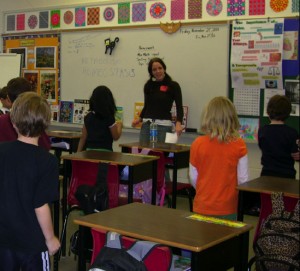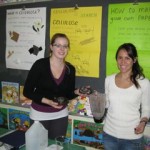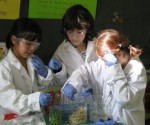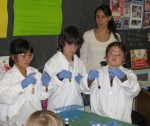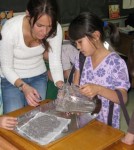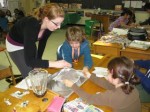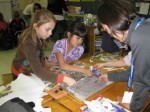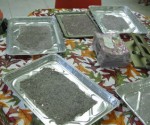Cellulose
October 6, 2011 in Plants
Like a tree, Molecules of Life grew into its 4th academic year, thanks to that the ever popular, multi useful , abundant natural product, cellulose, which was presented to Ms Sanchez’s 3rd grade class at École FACE School on Wednesday the 18th of November, 2009, by MoL Team Cellulose, Kim Beauregard (MSc student U Montréal) and Diana Rodriguez (Master student of Art Education, Concordia). Introducing cellulose, as a linear chain of sugar units , a principal component of cotton (90%) and wood (50%), Kim was pleased to see the students identify the many items made using this versatile polymer: clothing, paper, desks, chairs, the classroom door… and mentioned further the presence of cellulose in the thin transparent film, cellophane and the semisynthetic textile, rayon. For comparison, Kim also introduced starch, another polymer of sugar (glucose), which because of a difference in chemical linkage geometry adopts a spiral structure, instead of the linear cellulose strand.
The students then ground up a series of food samples (banana, celery, potato and bread) and compared them with sugar in a starch iodine test. After a brief discussion of lab safety, three students put on lab coats, lab glasses and gloves, and performed the test which produces a dark blue-black color in the presence of starch, the helical structure of which enwraps the iodine.
The utility of starch as glue for binding paper fibers was next demonstrated by Diana, who taught the students how to recycle paper. Shredding old newsprint, cardboard and old note paper, the students then watched their shredding mix in a blender with some corn starch to form a paper paste which they applied to screens to produce new sheets of hand-made recycled paper.
Discussing cellulose and starch, the students learned that although cows and termites can eat wood, it is the symbiotic micro-organisms that live in their guts, which allow these animals to digest the cellulose into the sugar needed for energy. On the other hand, humans cannot digest cellulose, which serves as ‘fiber’ to help digestive flow.
Happy to do some first hand recycling, the students thanked team cellulose for exposing them to the many products and properties of this key component of many of life’s simple comforts and food,
For more information about cellulose see: http://en.wikipedia.org/wiki/Cellulose
For more on the Starch – Iodine test see: http://www.elmhurst.edu/~chm/vchembook/548starchiodine.html
Resource for teachers about cellulose : http://moleculesoflife.ca/?p=931


